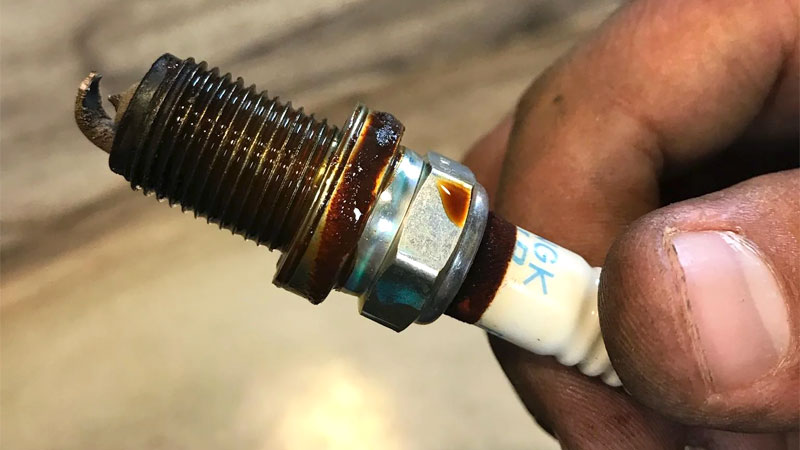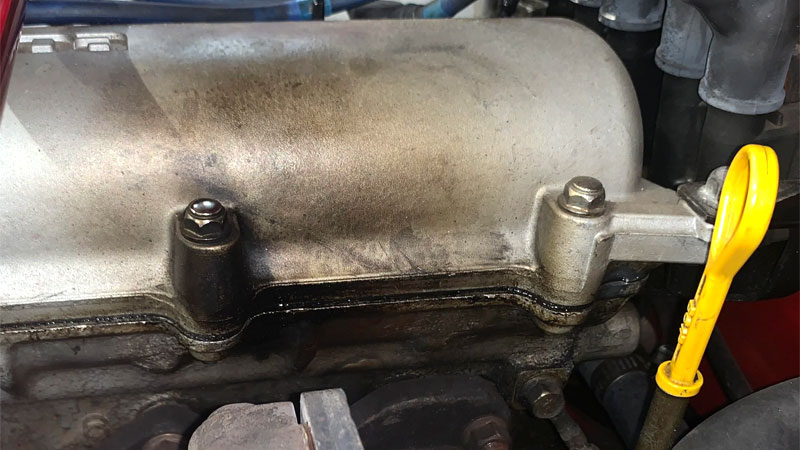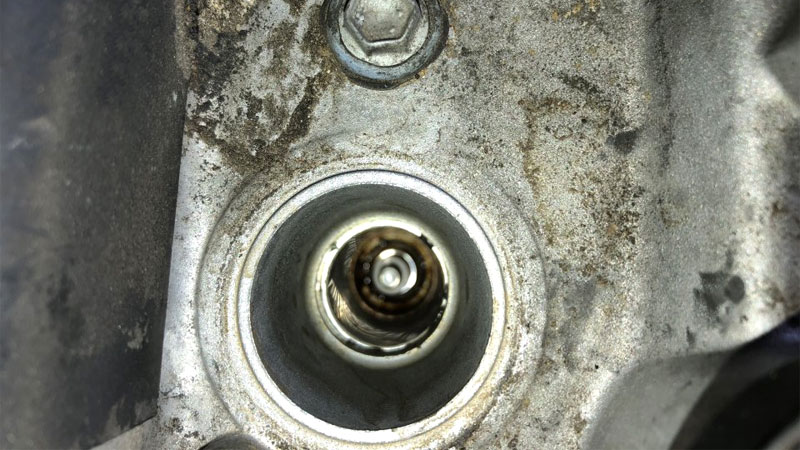Most motorists at least partially understand the function of a vehicle’s spark plugs, recognizing the importance of these pint-sized engine components. After all, a spark-ignition engine would be of little real value without a reliable source of spark. However, a spark plug is only able to function as intended, if it is in optimal condition.
In the era prior to onboard diagnostics, many mechanics used to periodically inspect a vehicle’s spark plugs, in a bid to uncover additional information related to overall engine health. Though this practice is not as prominent as it once was, it can still be of value when attempting to rectify spark-related issues.
One common observation made during spark plug inspection is the presence of oil, saturating the tip of an electrode. In other instances, one might notice oil pooling around one or more of an engine’s spark plug wells. While this is cause for obvious concern, there is much more to this equation than meets the eye.
Read on to learn more about the various causes of oil-contaminated spark plugs.
See Also – How to Change Your Own Oil
Is Oil on Spark Plugs Bad?
Oil contaminated spark plugs are never a welcome sight. However, this observation is not necessarily as dire as one might think, especially if this contamination is external in nature.
One prime example of this scenario is when an engine’s spark plug wells are full of oil. This is quite often a sign of external oil pooling, such as that caused by a faulty valve cover gasket.
On the other hand, excessive oil saturation of a spark plug’s electrode is somewhat more troubling. This generally means that an excessive amount of oil is making its way into one or more of an engine’s combustion chambers.
The severity of this condition is largely dependent upon the source of the oil itself.
Causes of Oil on Spark Plug Threads
There are a number of potential causes for spark plug oil contamination, some of which prove more dire than others. Understanding these causes often proves vital during the diagnostic process.
The following are several of the most common causes of spark plug oil contamination.
1. Leaking Valve Cover Gasket
A compromised valve cover gasket allows oil to leach from beneath the valve cover of an engine itself. As a result, this oil often seems into the void or well which encompasses the body of an engine’s spark plugs.
2. Compromised Plug Well Grommets
Many engines feature specialized grommets, which are intended to prevent oil from seeping into the plug wells mentioned above. However, these grommets are prone to aging and heat distortion, thereby providing reduced protection with time.
See Also – 4 Benefits of Changing Your Own Oil
3. Worn Valve Guides/Seals
An engine’s intake and exhaust valves are centered by a set of corresponding guides, each of which contains specialty seals to prevent oil intrusion into the combustion chamber.
With time, these seals can become worn, allowing oil to flow where it otherwise would not.
4. Damaged Piston Rings
A cylinder’s piston rings not only prevent compression loss but also keep oil from seeping into an engine’s combustion chambers as well.
However, worn or damaged piston rings can prove ill-equipped for this job, allowing oil to saturate the inside of one or more cylinders.
5. Cracked Piston
Another potential source of spark plug oil contamination is a cracked or otherwise compromised piston. When a failure of this type occurs, oil is allowed to pass from an engine’s crankcase, into the cylinder in which the damaged piston
Symptoms Indicating Oil on Spark Plugs
In many cases, a motorist can identify the presence of oil on one or more spark plugs through simple observation. This often proves helpful when attempting to remedy any issues that arise, in an expedited fashion.
The following are several of the most common symptoms of spark plug oil contamination.
1. Engine Misfire
Oil contaminated spark plugs tend to lack in their ability to provide ignition. This often presents itself as a misfire on one or more cylinders.
2. Blue-Colored Exhaust Smoke
Burning oil tends to produce blue-colored smoke, which is much easier to identify than white-colored smoke and its issues. In most cases, the exhaust of this color indicates oil contamination within at least one combustion chamber.
Exhaust smoke of this type also tends to carry a foul “burnt” odor.
3. Reduced Fuel Economy
Any reduction in combustion efficiency can lead to increased fuel consumption, with that caused by spark plug contamination being no exception.
If you have begun noticing increased pain at the pump, spark plug fouling might be to blame.
See Also – 8 Ways to Save Money on Gas
4. Backfiring
In severe cases, an engine can even begin backfiring due to the presence of oil contaminated spark plugs. This comes as the result of less than ideal combustion efficiency.
That said, a fuel related issue or a faulty ignition coil could also be the actual cause.
Can You Drive if Spark Plugs Are Wet With Oil?
It is certainly possible to drive with oil contaminated spark plugs. However, doing so is never advised.
First and foremost, a spark plug’s ability to arc as intended is severely hindered when saturated in oil. This, in turn, often leads to an obvious misfire condition. Furthermore, if the source of this oil contamination is not remedied, such spark-related issues will only worsen with time.
Additionally, operating a vehicle’s engine with oil-fouled spark plugs can cause a host of secondary issues, some of which can ultimately necessitate costly repairs. One example of this is catalytic converter damage that often results as a result of an unremedied misfire condition.
Will Oil in the Spark Plug Well Burn Off?
Oil found within a vehicle’s spark plug well will indeed burn off if the root cause of this oil-pooling is rectified.
However, if the source of this oil is not uncovered and repaired, additional oil will simply continue to pool in place, at a much faster rate than “burn-off” can take place. This, in turn, will lead to quite an overwhelming mess.
Assuming that the source of any oil-pooling has been addressed appropriately, any remaining oil will be burnt off within a reasonable matter of time. The exact amount of time that this process will take is largely dependent upon the duration of drivetime accrued at operating temperature.
How To Remove Oil From a Spark Plug Well
Oil can be removed from a spark plug well in a number of ways. However, the most effective tends to be by way of a shop towel.
A light amount of brake cleaner or carburetor cleaner can be used to thin out any offending oil before any attempt is made to soak up remaining contaminants.
A shop towel can be tucked into the spark plug well with the use of an extension, or another similar elongated utensil. This shop towel should be left in place for 10-20 minutes, allowing plenty of time for it to soak up the bulk of oil which remains.
Can the Spark Plugs Be Re-used?
While you might have observed a past acquaintance cooking oil contamination off of a used spark plug with the assistance of a hand-held propane torch, doing so might not be the best course of action.
While such methods do work to a certain extent, these practices are best reserved for use when attempting to start a motorcycle or lawn mower, not a vehicle.
Spark plugs are relatively cheap to purchase, and often now come pre-gapped, saving both time and effort during the installation process. Therefore, there is little reason to reuse old, marginalized spark plugs of any type.
- History of the Chevrolet SSR: The Retro-Styled Convertible Pickup - Apr 25, 2024
- The History of the BMW M Coupe (the “Clown Shoe”) - Mar 26, 2024
- The History of the Ford Flex - Feb 28, 2024





Hi I’ve a 1974 chev Vega 140 2- barrel number 4 gets really oily very quickly even after replacing the plugs 6 mile drive it in town. & a lot of blue smoke. Has 150 psi in each cylinder not sure were too look any help would be very welcomed thank you. Engine was replaced with remanufactured engine in 85 it until I got it in 2017 completely restored the car but no engine or Carb. Work.